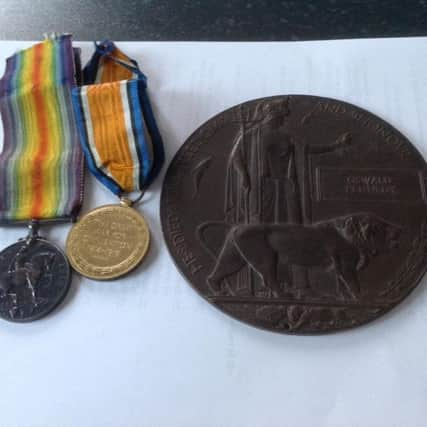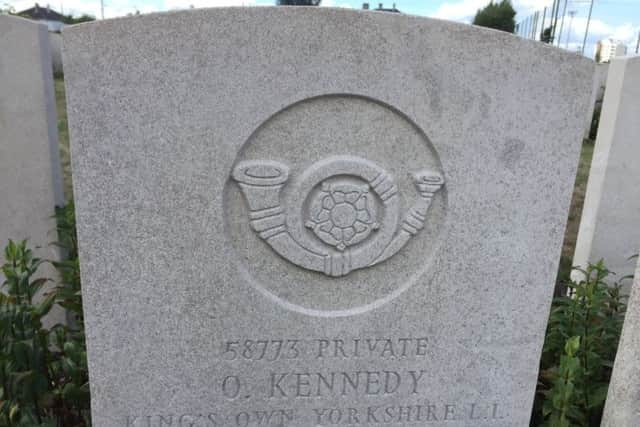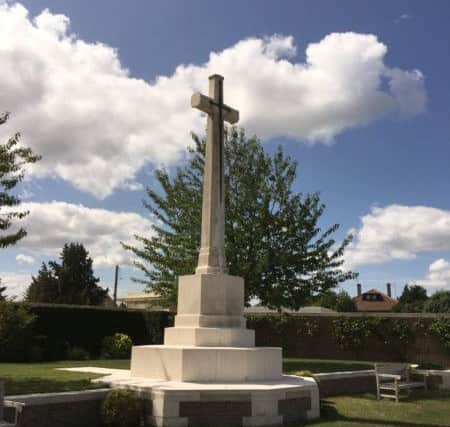He died from his wounds - days before the war ended


At just 14-years-old, he was working at the pits.
But even worse was to follow just seven years later, and exactly 100 years ago, when he served his country on The Front.


Historian and researcher Kevin Dance reports.
Just weeks before the end of the First World War, Private Oswald Kennedy – a man of South Hetton – was in the thick of the action.
Advertisement
Hide AdAdvertisement
Hide AdHe was 21 and serving with the Kings Own Yorkshire Light Infantry (KOYLI), which was helping drive the Germans on the retreat.
Yet despite their rearguard action, the enemy was still fighting hard and their machine gun posts were proving hard to knock out.


Oswald, or Ossie as he was known to many, was wounded in the heavy action of September 1918 and removed from the front line.
First came treatment in a Field Hospital before Ossie was moved to another hospital 100 miles away – probably in a bid to get him ready for an evacuation back to Blighty.
Advertisement
Hide AdAdvertisement
Hide AdBut he never made it home. While he was in hospital at Rouen, Ossie succumbed to his wounds and died on October 4, 1918. He was only 21-years-old.
Kevin said: “He is remembered with honour at the St Sever Cemetery Extension, Rouen.”
But behind the brief details of war lies a story of a whirlwind few months for the young South Hetton man. He had only been called up to serve in the British Army five months earlier.
At first, he was posted to the 11th Battalion Durham Light Infantry.
Advertisement
Hide AdAdvertisement
Hide AdBut after several months training in the UK, Oswald arrived in France in early September 1918 and was immediately and permanently transferred to KOYLI – probably because of the levels of casualties it had taken in the past few months.
His new unit was heavily involved in the Hundred Days Offensive. It was an Allied initiative that effectively ended the First World War and resulted in the Germans eventually retreating to the Hindenburg Line.
First, though, came a short period of training and re-organisation which was done at Behagnies, 10 miles south of Arras in Northern France.
On September 11, the unit was ordered to move back into the front line at Havrincourt, where they spent the next three days involved in heavy fighting before returning to Behagnies.
Advertisement
Hide AdAdvertisement
Hide AdFurther movements followed for the Battalion before they were given a new objective on September 27 ... to capture the village of Ribecourt.
Kevin told us: “Upon reaching the outskirts of the village, the 2/4th KOYLI found that a Company of 4th Royal Fusiliers were being held up by machine gun fire.
“Captain Spencer, Officer Commanding A Company 2/4th KOYLI, moved forward and with the aid of Lewis Guns knocked out three machine gun posts allowing the fourth Royal Fusiliers to move on.”
There was further enemy opposition when two field guns opened fire.
Advertisement
Hide AdAdvertisement
Hide AdBut they were “quickly silenced by rifle and Lewis gunfire from 2/4th KOYLI B Company,” said Kevin.
The fierce fighting left KOYLI extremely weak and suffering from a large number of casualties after capturing Ribecourt.
“The Officer Commanding asked for assistance from B Company before advancing further,” said Kevin.
“By the time that hostilities ceased at 11am on November 11, 1918, 2/4th Battalion KOYLI had advanced a further 45 miles east from Havrincourt in their pursuit of the retreating German Army.”
Advertisement
Hide AdAdvertisement
Hide AdBut the casualties suffered included Ossie and he paid for his bravery with his life.
His mother Isabella was awarded £4 19 shillings and 3d and Oswald was awarded the Victory and British medals.
It was a tragic end to a young life.
Oswald was born in 1897 to parents William and Isabella and in 1901 the family were living in Front Street, South Hetton.
There were seven children – Oswald was the second youngest – as well as a boarder.
Advertisement
Hide AdAdvertisement
Hide AdBut by 1911, Oswald was a 14-year-old who was supporting his family by working as a “screener on the coal belt above ground,” said Kevin. It was vital money as the family had grown to 11 children of which 9 had survived.
Sadly, Ossie was soon to swap coal mines for conflict and pay with his life.